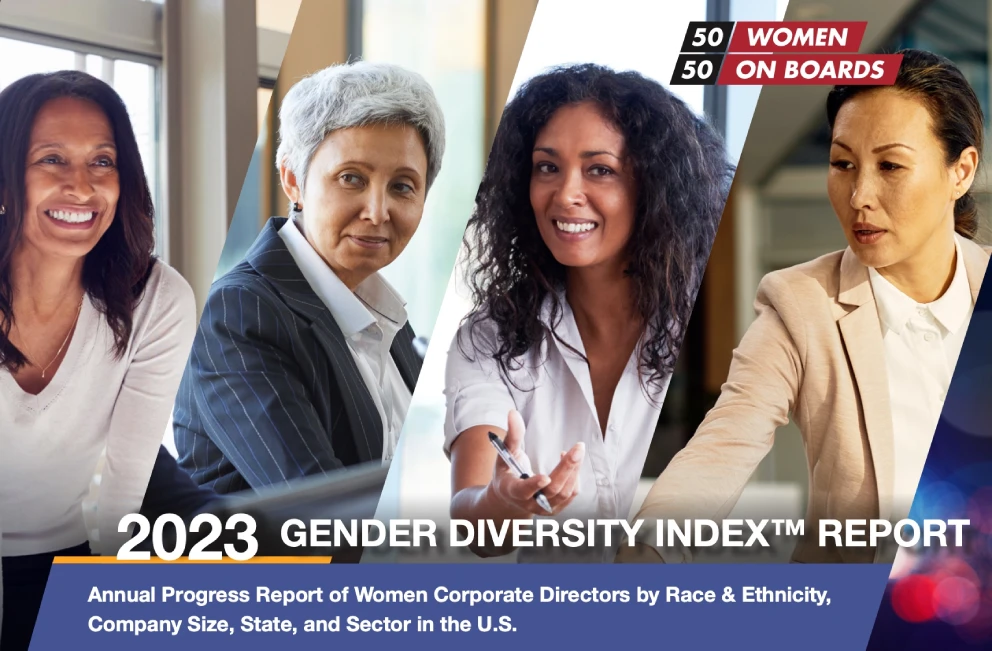
GENDER DIVERSITY INDEX™
Fourth Quarter 2024 Key Findings


GENDER DIVERSITY INDEX™
Fourth Quarter 2024 Key Findings

PROGRESS OF WOMEN ON RUSSELL 3000 COMPANY BOARDS STALLS
Our latest report, in collaboration with our Exclusive Data Partner Equilar, highlights for the first time since we began tracking all public companies in the U.S., progress of women on Russell 3000 company boards stalls. Women continue to hold 30.2% of board seats as reported in Q3, showing only a 0.6 percentage point increase from the previous quarter.
Notably, only 26.3% of the 419 new board seats were filled by women, a significant drop compared to the 40% averages seen between 2020 and 2023. Furthermore, 40% of companies still have boards with two or fewer women, highlighting persistent gaps in gender diversity.
The representation of women of color also remains unchanged at 7.7% of all board seats, underscoring the need for more targeted efforts to achieve intersectional progress.
of board seats held by women.
of board appointments were women; compared to 32.1% for all 2024.
of newly filled seats by women were seats added to boards.
COMPANY RATINGS
In Q4 2024, the number of gender-balanced boards declined by two companies, offset by an increase in boards with three or more women, which grew by two companies to represent 45.9% of public companies.
Despite these shifts, the overall percentage of gender-balanced boards rose slightly from 13.8% to 13.9%. Meanwhile, companies with no women on their boards decreased by four, while boards with one or two women declined by 13 companies in each category. These changes are attributed to the Russell 3000 index shrinking by 30 active companies compared to the previous quarter.

Our company ratings categorize public boards as Gender Balanced, or with three or more women on board, two, one, or zero, providing a comprehensive snapshot of their gender diversity profile.
406 companies, down by 2 companies from Q3 2024.
1,337 companies, up by 2 companies from Q2 2024.
756 companies or 26% have 2 women; 353 or 12% have one woman; and 64, or 2% have 0 women.
RACE & ETHNICITY
In the latest findings, 42% of directors disclosed their race and ethnicity, unchanged from last quarter. Notably, 52% of women disclosed this information, compared to 38% of men.
People of color held at 19.1% of board seats, with women of color at 7.7% and men of color at 11.5%. Given that women occupy just 30% of all board seats, these figures emphasize the need for greater board diversification.
- Women
- Men
Companies By Sector
The Utilities sector continues to stand out with 36.4% women on boards and 27.4% gender-balanced companies. There are no utility companies with zero women on boards and only 12 companies that have 2 or less women. The Energy and Financial Services sectors are the least gender diverse with less than 28% women and less than 10% gender balanced boards.
UTILITIES
36.4% Women on Boards
27.4% Gender-Balanced Boards
CONSUMER DEFENSIVE
34.0% Women on Boards
19.5% Gender-Balanced Boards
CONSUMER CYCLICAL
32.7% Women on Boards
19.2% Gender-Balanced Boards
REAL ESTATE
31.5% Women on Boards
19.8% Gender-Balanced Boards
HEALTHCARE
30.7% Women on Boards
17.1% Gender-Balanced Boards
TECHNOLOGY
30.1% Women on Boards
11.1% Gender-Balanced Boards
BASIC MATERIALS
30.1% Women on Boards
11.0% Gender-Balanced Boards
INDUSTRIALS
29.4% Women on Boards
10.9% Gender-Balanced Boards
COMMUNICATION SERVICES
28.5% Women on Boards
10.8% Gender-Balanced Boards
FINANCIAL SERVICES
27.6% Women on Boards
8.5% Gender-Balanced Boards
ENERGY
27.2% Women on Boards
8.5% Gender-Balanced Boards
State Progress
Our state-level data reports on the percentage of women on boards and gender-balanced publicly traded companies. California continues to lead with 33.6% women on boards (a 0.2% decrease from the previous quarter) and 21.2% gender-balanced companies (a 1.3% decrease from Q3), while Nevada and Florida have the fewest women on boards.
WOB = Women on Boards GB = Gender Balanced
GB = Gender Balanced
- Exceeds
- Average
- Below
When Women Lead
Our findings continue to underscore a clear correlation: when women lead, boards are more diverse, with both the % of women on boards and women of color exceeding national averages. Conversely, in the absence of female leadership, both metrics fall below the national average. This highlights the pivotal role female leadership plays in driving diversity on corporate boards and beyond.

WOB = Women on Boards POC = People of Color W POC = Women People of Color GB = Gender Balanced
Women CEO
Women Board Chair
Women Nom Chair
When Women Hold All Three Positions
No Women Leader
WOB = Women on Boards
POC = People of Color
W POC = Women People of Color
GB = Gender Balanced
Women CEO
Women Board Chair
Women Nom Chair
When women hold all three positions
No Women Leader
METHODOLOGY
50/50 Women on Boards Gender Diversity Index ™ reports on the gender composition of corporate boards on the Russell 3000 Index. Using the data provided by Equilar, we analyze, track, and publish data on our website in our Gender Diversity Directory. This report reflects data as of December 31, 2024 with 2916 active companies on the Russell 3000.
START YOUR BOARD LEADERSHIP SEARCH OR SUPPORT OTHERS ON THEIR JOURNEY
What Women Can Do
Advocate: Highlight and share your expertise for boards.
Invest: Request employer-funded programs to advance your board journey.
Network: Volunteer, join non-profit boards, attend events, and outreach to your contacts to ensure they are aware of the board opportunity you are seeking.
Be Intentional: Leverage our GDI directory to narrow down your board search.
What Corporations Can Do
Career Support: Provide employee engagement programs that sponsor women’s board readiness training.
Partnership: Support organizations like 50/50 Women on Boards to advance women.
Diversity: Aim for a board with at least three or more women and leverage diverse candidate lists like 50 Women to Watch for Boards.
What Men Can Do
Promote: Mentor and recommend women for board roles actively.
Inclusive Boards: Encourage women’s contributions, especially with fewer than two women on the board.
Succession: Ensure women, including women of color, are on board candidate lists.
Code of Conduct: Governing Data & Emerging Tech
Boards are no longer observers of emerging technology; they are stewards of how it’s governed. This panel goes beyond awareness to examine how directors can structure oversight, define accountability, and measure governance effectiveness in AI, data use, and digital innovation. Panelists will share practical strategies for building governance systems that ensure transparency, ethical decision-making, and responsible innovation at scale.
Speakers include: Sita Lowman, Nithya Das, Suresh Sharma, Byron Loflin
Your First Board Meeting: A Director’s Playbook
Tactics that Work: Case Studies in Navigating Shareholder Activism
Inside the Boardroom: Resilience Planning in Action
Reputation & Response: How Boards Navigate Shareholder Activism
As shareholder activism intensifies, boards face mounting pressure to defend strategy, protect corporate reputation, and engage stakeholders with clarity. This panel brings together seasoned directors to explore how boards can respond effectively while maintaining credibility, board alignment, and stakeholder trust. Hear real-world insights on navigating activism in today’s high-stakes, high-visibility environment.
Speakers include: Gaby Sulzberger, David Cahoy, Rachael Coffey, Eduardo Gallego
Navigating Global Markets: Trade, Tariffs, and Supply Chain Strategy
As global disruptions reshape business models, this panel will explore how boards can navigate the practical complexities of trade, tariffs, and supply chain shifts across regions. Panelists will share how directors are guiding companies through regulatory changes, sourcing challenges, and new market risks, while seizing opportunities for growth and operational agility.
Speakers include: Titi Cole, Mia Mends
Strengthening Oversight: Risk Management and Board Resilience
This keynote will equip directors to think globally about risk through the lens of geopolitical foresight, cross-border tensions, and long-term instability. Learn how boards can strengthen oversight and guide enterprise-wide resilience by anticipating disruption and embedding a proactive risk culture in a changing world.
Speakers include: Rodger Baker







